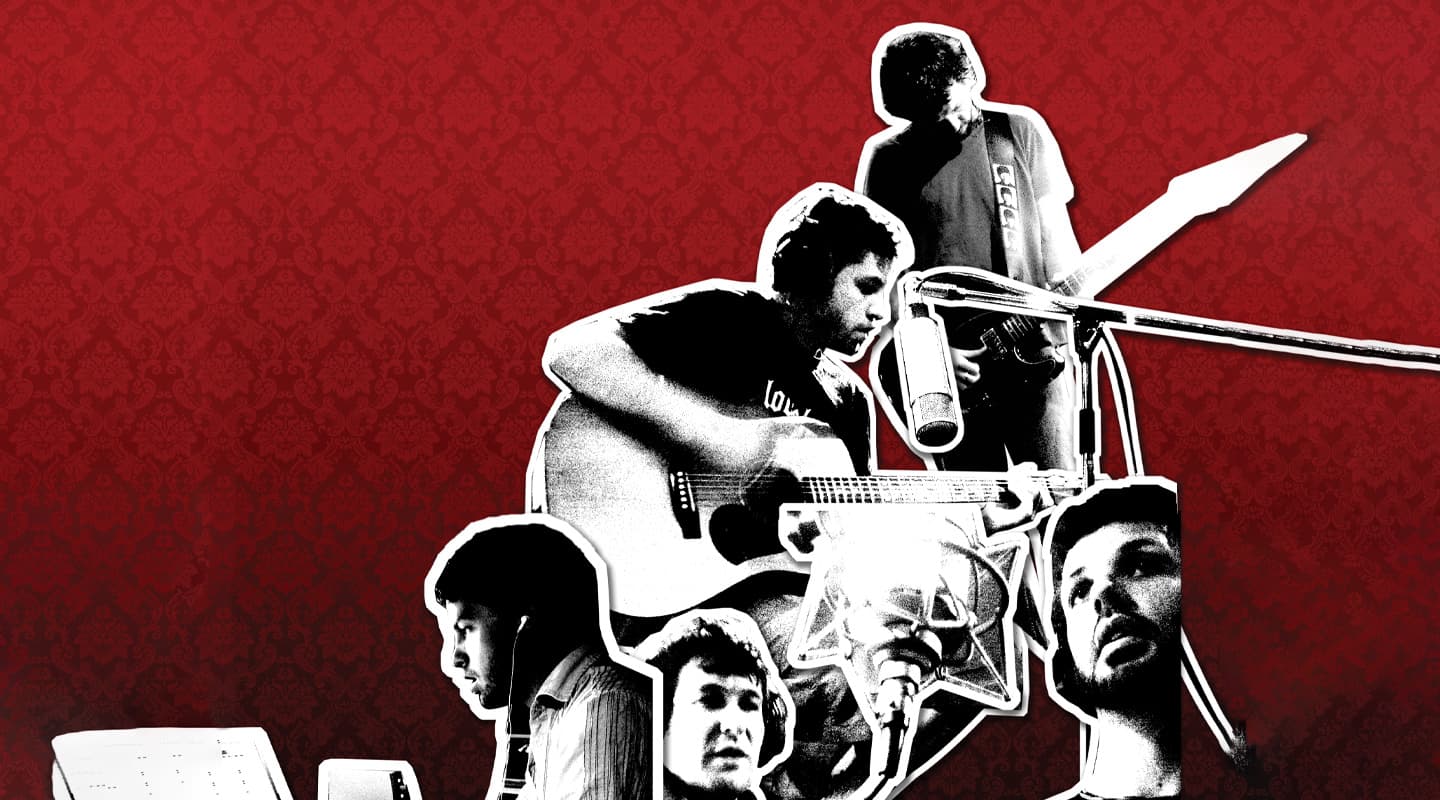
Recording Eskimo Joe
Eskimo Joe pulled out all stops to produce its latest commercial hit Black Fingernails, Red Wine and the results have taken the country by storm. AT talks to the album’s engineer, Matt Lovell, about beer and, to a lesser extent, recording.
My first encounter with Eskimo Joe’s latest album, Black Fingernails, Red Wine was a couple of months ago now. I had the telly on in the background late one Saturday morning while I was whipping up a ‘big breakfast’ – as my partner always calls them – and through the sizzling white noise generator of bacon in a frypan, I was struck, from the moment Black Fingernails, Red Wine began, by the size of the drum room that had apparently been used to record the kit – a classic engineer’s reaction to a song I s’pose.
I had no idea at that stage that it was Eskimo Joe’s new single; I assumed it was some dudes from the US. Regardless, my attention was immediately piqued by the kick drum sound, which instantly reminded me of U2’s rendition of Unchained Melody (which came out as a single B-side long ago). That track had possibly the biggest ‘stadium rock’ kick drum sound I’ve ever heard on a recording. It’s so enormous it actually messes with the rhythm of the song, but as a sound it’s quite something… at least that’s how I remember it.
The new Eskimo Joe album is painted with a similar brush. According to ARIA Award-winning engineer Matt Lovell, who recorded Black Fingernails…, one of the main ambitions for the album was to “emulate that stadium rock vibe by placing some big slap echoes subtly behind the sounds” and it’s worked a treat. The single had only been playing one second before I was tricked into imagining such a space, even through the din of my morning fry-up.
The new Eskimo Joe album, which almost everyone in the country is surely aware of by now – it was No.1 for about three weeks, slipped back a couple of places for a brief time before resuming the top spot again – has been one of the biggest selling Australian records of the year, and it’s not been by accident.
Demos and pre-production started some time ago now, with Kav Temperley, Joel Quartermain and Stu Macleod [collectively Eskimo Joe] developing the songs at home in Perth on their ProTools rig with a clear vision and ambition for the record: “an album of three and a half minute epics!” was the fundamental aim. It would seem this ambition has been superbly realised from conception right through to the pressing plant.
Confident of their arrangement skills and vision for the album (as well as being pretty technically savvy), Kav, Joel and Stu decided to produce the album themselves, which is unusual for a band with the luxury of a substantial budget. Most often, a producer is called into action if funds allow it (usually for good reason) but, in this case, the band was utterly convinced that they could manage without one. So the band hooked up with Matt Lovell and headed to The Grove Studios (formerly Garry Beers’ Mangrove Studios, which is located on a farm near Gosford) in the height of last summer to sink their teeth into an extended recording session.
In anticipation of the Eskimos suffering terribly in the summer heat, Matt brought along a keg of his own beer! Literally! And, I mean, what engineer worth his salt wouldn’t?

![Live-Rm-1[4]-pichi](https://www.audiotechnology.com/wp-content/uploads/2021/11/Live-Rm-14-pichi.jpg)
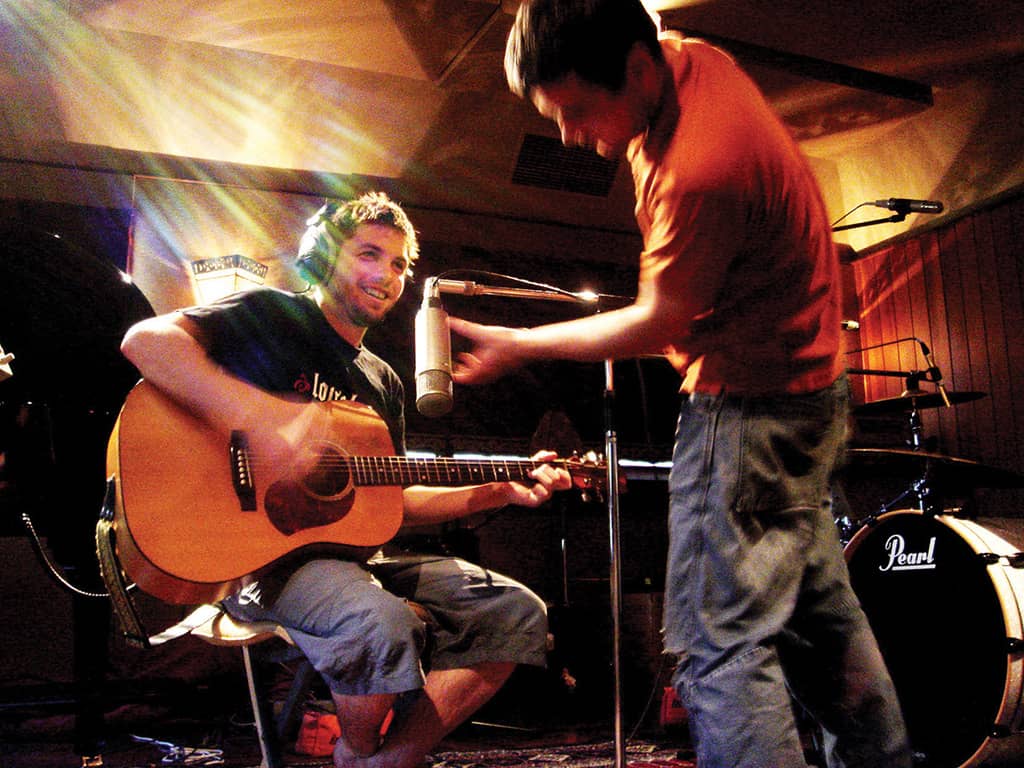
LOVELL’S LAGER THAN LIFE
Andy Stewart: What’s the story with the beer Matt; I hear you have your own label?
Matt Lovell: That’s right, it’s called Lovell’s Lager, which I’ve been brewing commercially for a couple of years now. It’s on tap at the Annandale and The Cricketers’ Arms in Surry Hills [in Sydney] but I’m about to venture into bottles and cases…
AS: So do you do a lot of the taste testing yourself?
ML: Yeah, a shitload of testing. Last week was all testing… (laughs)
AS: Hard work by the sounds of it…
ML: Very hard work! Bottles will be a big step up financially, though. But it’ll be worth it, because kegs are a nightmare to be honest…
AS: Hard to get through you mean?
ML: Nah, delivering them is the problem. For each keg on tap you have to have five kegs in a loop; one getting cleaned, another one filled, one on a truck… etc.
AS: Where’s the beer brewed?
ML: At the moment I’m making it in Cessnock in the Hunter Valley, but I’m just about to move production to a new place in Camden. These are the new bottle labels and cases… [Matt shows me the artwork for the labels, etc and on the bottom of the slab artwork is a ghetto blaster!]. I’ve got that there for when you’re carry the slab on your shoulder…
AS: Dare I ask what has prompted this foray into, what I can only imagine is an occupational hazard of heady proportions?
ML: Dunno, I guess it’s something I’ve always been interested in – beer, home brewing etc. I wasn’t very successful at it though. The idea came to me when I was doing the last Jebediah record over in Perth and I went down to a brewery in Fremantle called Little Creatures and realised that there was nothing like it on the East Coast. And it was just like, ‘Well, f**k it, I can’t rely on the music industry for the rest of my life – or the next six months’ [more hysterical laughter] – so I adopted the old punk rock ethic of doing it yourself… and now it’s a reality.
AS: So how do you decide on the taste?
ML: A lot of testing.
AS: Are you kidding me? It’s not just someone else’s beer with a different label on it?
ML: No! We’ve got a recipe – it’s a heavy, sweet lager at the moment, but I’m actually changing it a bit now into a lighter, more ‘Becksy’-type vibe. It’s not meant to be the world’s greatest beer, it’s supposed to be a ‘drinking, get amongst it’ beer.
It’s a slow growth business. I see it almost like starting a band: you start playing gigs at The Hopetoun, then a gig at the Annandale, then with any luck you get a song on Triple J and organise a tour up and down the east coast. You slowly build it up like that. It’s taught me a whole new set of business skills, that’s for sure!
AS: So was there free beer during the Eskimo Joe recording session then?
ML: I did take a keg up to The Grove actually, but the problem was we didn’t have very good refrigeration up there and it was the middle of summer so it went off very quickly, because Lovell’s Lager is all natural with no additives or preservatives in it. I tried to keep the keg in a really cool spot but the thing went off in about three days…

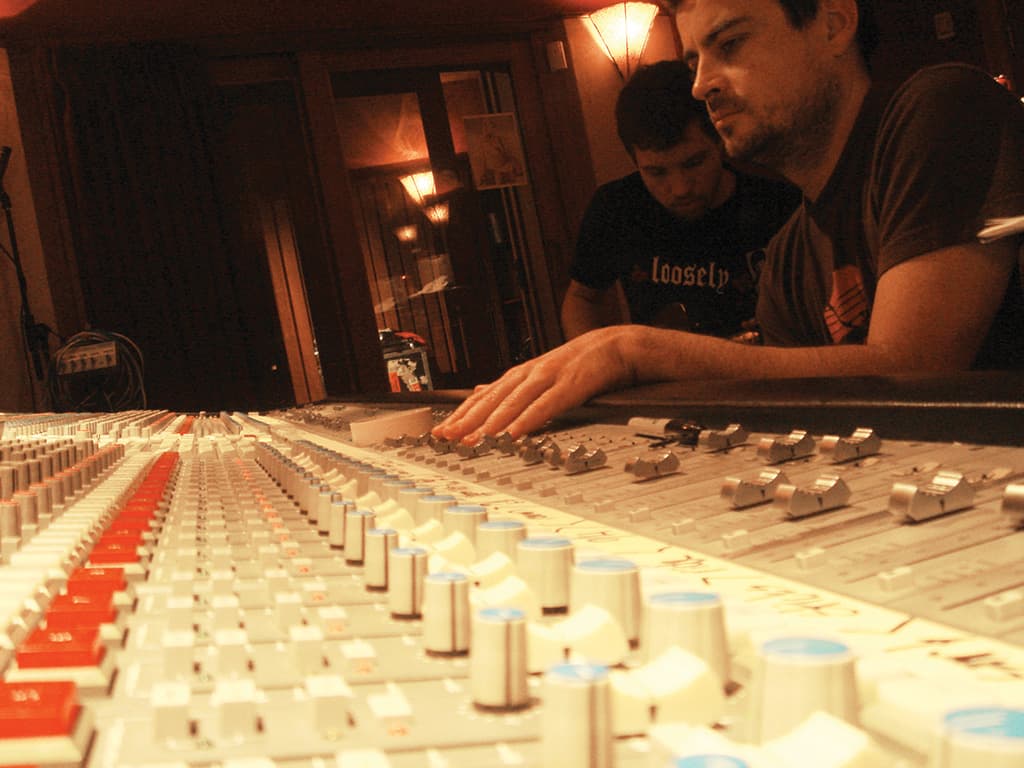
GETTING BACK ON TRACK
AS: Sorry to digress from the beer making for a minute, but how did Black Fingernails, Red Wine come to be made at The Grove?
ML: The whole idea was that the band were going to produce the record themselves… which I thought was really cool. The demos sounded fantastic; they’d worked really hard and long on the songs and they knew exactly what they were doing and exactly what they wanted. They didn’t need a producer to come in and take things apart or change parts up or do anything, really. It was all there in the demos, so the sessions were basically about re-recording the ideas they’d already clearly defined.
The band had already decided to record at The Grove before I got the call, but I’d coincidentally worked there and helped Garry Beers set it up, way back when. I worked there for the first year of its operation; I was the in-house guy there.
AS: So it was like a homecoming of sorts for you?
ML: Yeah, and it was really good to be back. It obviously has a different vibe now, because no one lives at the house any more; you’ve got the whole property to yourself. We were playing cricket every afternoon in the driveway this time around and swimming in the pool. Whereas before you couldn’t really play cricket in the driveway…
What’s great about The Grove is you can live there while you’re recording, do your own hours and get stuck into it at your own pace.
AS: Did the tracking process go fairly smoothly?
ML: Yeah, we had a great time. The band are such great players – they can all play everything, they know one another’s strength and weaknesses intimately and there’s no bullshit between them, which just makes the process so much easier. So, for instance, during the tracking session, if Joel got a part on a guitar but couldn’t really nail it for whatever reason, Stu would be able to sit there and work it out, and then play it – or vice versa. Whoever could play it the best just went ahead and recorded it, which is a great way to be able to work…
AS: How long were you all ensconced?
ML: We didn’t have a lot of time pressure on us – six weeks just to track it, which was great. And we recorded the album one song at a time. We’d start by getting about three drum takes down and then attack the overdubbing of one of them until we’d finish off all the vocals, guitars, keyboards… everything – before tackling the next song. We recorded all the drums, bass and whatever the main instrument happened to be to The Grove’s Studer A827 tape machine and then banged it into ’Tools and went from there.
AS: No parts from the original demo sessions were kept then?
ML: There were a couple of songs where the demos had some kind of specific delay guitar effect on them, like the start of New York for instance, where in the demo’ing they’d hit the right delay on the Line6 pedal, which we couldn’t really replicate, so in that instance we just imported that part from the original ’Tools session and placed it into the new one. There was also a keyboard part at the start of Setting Sun where, again, we couldn’t get the same sort of distorted keyboard sound, and even though it was a slightly different tempo on the original recording, we just nipped and tucked it and in it went.
AS: Was there much room for experimentation or had all of that already occurred in the demo phase?
ML: Basically, all the parts for the album were there, there was a little bit of experimentation but mainly the recording was about getting the right tones and sounds, rather than inventing parts. For instance, a lot of the keyboards and any sort of pads and lead lines often went through pedals or an amp. We were never complacent or tempted to use generic sounds. We’d put one side of a sound through an [Electro Harmonix] Micro Synth and the other side through a blue Line6 [MM4 Modulation Modeler] pedal – that sort of thing – so you’d get that width by twisting it a bit and making it more analogue sounding. It made the sounds unique.

DISCIPLINED AMBITION
AS: The album sounds very refined, very controlled… was that discipline evident right from the start of the project?
ML: Yeah, it was. The guys had a real vision for where they wanted to take the record, and they’d planned it out very early on. They said to me a few times they wanted ‘three and half minute epics’ and a ‘stadium rock’-type vibe, so that’s the direction we headed in.
AS: How did you go about getting that vibe in the studio?
ML: Well, for starters everything on the album is played. By which I mean ProTools was used as a tape machine and not as an editor. I never cut and paste choruses, things like that… it really kills me to even contemplate that stuff. So everything was played and at no point did we get lazy about that. All the vocals are sung wherever they were required – there’s no AutoTune, it’s all performance-based – and that brings a lot of the vibe and feel to the record.
AS: And yet it’s very tight and polished… and at the risk of comparing them to other bands, the album reminds me very much of bands like INXS and even Billy Idol at times. There are a few real White Wedding moments… The drums, for instance, are very up front and powerful.
ML: Yeah, the drums are a good example of how we typically tracked things on the record. I used about 18 tracks of drums – lots of room mics, distorted room mics, close mics. Essentially all the distorted room sounds on the album were generated during the tracking rather than mixing, and that was typical of our approach to the whole album. We weren’t relying on the mix stage to ‘create’ the sound; we did it all during tracking.
AS: Including establishing the ‘stadium’-like vibe? How did you manage that?
ML: Basically, every record I do these days – not just Eskimo’s – involves a lot of room recording and we paid a lot of specific attention to this on Black Fingernails. I had room mics up for just about everything. I fed a lot of sounds through amps that were then recorded by room mics – a lot of keyboards and backwards effects bits and pieces – so you’ve got that natural space of the studio embedded in the sounds. I much prefer that to artificial reverb spaces, whether it’s a [Lexicon] 480L or whatever. A lot of sounds were recorded with effects and spaces because we always knew that someone else would be mixing it. We wanted to make sure that all the effects we intended a sound to have went with the sounds during tracking.
AS: So were these spaces and effects captured so that mixing was effectively a fait accompli or so the mix engineer had options?
ML: Both really. Tim [Palmer, who mixed it at Paramount studios in Hollywood] definitely had a lot of options on the drums, but the idea was to provide the mix engineer (whoever that was going to be) with finished ‘songs’ and that included every aspect of each instrument’s sound.
AS: You can hear that Tim Palmer seems to have done a lot of switching between mics in intros and choruses; bombastic front-end power from close mics and room mics that explode into choruses. Big snare, big kick drum… he clearly had lots of options to work with.
ML: That’s right. Although, a lot of those decisions were edited on the ProTools files by us. For instance, I’d have the room mics muted for some sections and all the front-end mics cut out in another so that Tim didn’t have to make all those arrangement decisions himself. He was able to boot the sessions up and there they’d be, largely arranged both in terms of instruments and dynamic mic choices.

INTELLIGENT DESIGNER
AS: Can you tell me more about the various recording setups?
ML: Well, for drums I recorded clean room mics – you know, standard compressed room mics – and I had an RCA ribbon through an SPL Transient Designer. Actually I had three room mics through the Transient Designer: one in front of the kick, another that would move around the place and a third mic that I’d put up in the corner. And I’d move them around for each song so there was a lot of variety in the ambient mics. The thing about the Transient Designer is that it’s capable of giving you everything from an enormously far away over-compressed sound, to a dried up, gated close mic sound. It only has attack and release functions and that’s it. I have no idea how it really works but it sounds amazing on room mics! [See box item for a brief explanation of the Transient Designer.]
AS: I assume you had basic front-end drum mic setups as well as these ambient mics. Were any of the ribbons facing across the room with the null point facing the drumkit, or were they mainly facing directly at it?
ML: Most of the ribbons were aimed directly at the kit, down low about four metres away from the front of the bass drum. There were a few times when I stuck a mic behind Joel’s head for a different drumkit balance.
AS: What about the things you were running through amps?
ML: We spent a lot of time putting vocals through guitar amps after the takes were finished. And on songs like Comfort You, for instance, just about everything is going through amps. But funnily enough, the bass never went through an amp on the entire record. It was only ever DI’d.
AS: How were the guitar amps miked up?
ML: I had a Rode Classic II valve condenser and a Shure SM57 up close. The Rode copes well with life in front of an amp, and of course the 57 needs no explanation. When I needed the sound to be pokier I pushed the 57; and when I wanted the sound to be rounder and fatter I pushed the Classic II. I also had a room mic set up – usually a Neumann U67. For me the part dictates the sound and I’ve almost abandoned EQ on guitars, it’s more about percentages of the different mic tones these days. I often bus all three mics together too, into either an [ELI] Distressor or a [Urei] 1176. And tonally, instead of punching in EQ, I prefer to change the guitar, change the pickup or change the amp. And there’s no AmpFarm anywhere on the Eskimo Joe record, only real guitar amps and effects.
AS: Were effects printed to separate tracks or integral to the guitar signals as well?
ML: We used a Line6 pedal on everything as well as the Micro Synth and all of it was tracked as part of the sound. So the enormous guitar sounds that are common throughout the album were performed and recorded with that scale in the first place.
AS: So Tim Palmer’s mixing didn’t transform dinky little guitars into massive stadium guitars then?
ML: No, he certainly helped it along a bit, but he hasn’t transformed sounds from chalk to cheese. The boys had a real vision for the sound, as I’ve said, and the process for me was really about helping them achieve what they heard in their head. And I’m a great believer in recording all effects to tape anyway. I like building a finished sound and saying, ‘that’s it, that’s the sound’.
AS: The Grove obviously has recording rooms that you’re happy with then…
ML: Yeah it does. It doesn’t have a really high ceiling, which is a little odd, but it works. For guitars, I had the amps in the main room facing into the back corner where there’s a smaller room that has a wall of white volcanic stone. I had the U67 in there switched to ‘omni’ and the sound was enormous.
We spent a lot of time putting vocals through guitar amps after the takes were finished. On Comfort You, for instance, just about everything is going through amps


MORE STADIUM ROCK
AS: Can you tell me more about realising the ‘stadium rock’ sound in the confines of the studio?
ML: The stadium vision was essentially about slap echoes. You know that slap that you hear when you’re at a big gig? That was the illusion we were trying to create. There’s a lot of it placed subtly on the record. Black Fingernails is a good example of that. I think that song has three kick drums making up the kick drum sound. There’s the real kick, a tighter, sampled kick underneath it to improve the front-end clarity and another third bass drum that was sent out to a Matchless amp, distorted and recorded back into ’Tools via a room mic, so it’s a bit smaller but more ambient sounding. And because there was an inevitable delay created by the re-recording chain, the new sound was slightly behind the beat – if you looked at the ProTools waveform it was obvious. My first reaction was, ‘well, we can’t have that, I’ll just slip that back into time’, and then I thought, ‘No no, hang on, let’s listen to it first’. When I heard the effect of it, it sounded like a slap back and it just worked. It was one of those serendipitous things that we hit on and kept. It gave the track a really powerful darkness. I tried taking it out at one stage, but as soon as I did, the kick lost a lot of its power. And if that third bass drum hadn’t been distorted through the air or was just the same kick delayed, it wouldn’t have worked.
AS: Did you come away from the process having learnt any new tricks?
ML: It was more of a distillation of ideas. It was one of those records that had a lot of very cool non-commercial sounds on it and the trick was making them work within the ‘epic’ intention of the overall sound. We were determined to record the album one song at a time, and we did. There are often times where you say you’re going to approach a record in such ’n’ such a way, but then the reality of the session takes over and the idea fizzles out. With this record we really followed through on our ideas.
AS: Can you give me an example of how that helped?
ML: A good example was that Kav had set times where he felt really comfortable singing and we stuck to that plan and it worked really well for him – and consequently I think his vocals on the record sound fantastic. He was mostly singing into a Neumann M149 (because that’s what he used on Eskimo Joe’s last record with Paul McKercher). And because vocals are so vitally important I figured if he was happy with that mic, I was more than happy for him to use it for the sessions. I didn’t want to try and reinvent the wheel for him; I wanted him to be comfortable. Having a mic with a proven track record on his voice helped him relax and not worry about his vocal tone. The rest of the chain was a Telefunken V72 preamp into an 1176 and an LA-2A (the LA-2A not really doing much… it was there just in case).
When we tracked vocals we’d do four or five takes and then comp. And because Kav had this regular time frame to sing in, he’d spend the day really building up to it. He sang in cans; The Grove has a really good monitoring setup that allows you to create your own headphone mix. There were gobos on either side of him, and again, I generally prefer to record vocals in a space that’s not too shut down. But, more importantly, that was Kav’s preference as well, and, to me, him feeling comfortable was way more important than my thoughts on the matter. My attitude was simple: ‘If he’s comfortable doing that, then let’s do that. Kav’s the singer… Kav’s comfortable with that… so that’s what we’re doing’.
But of course there were some times when Kav would do a couple of takes and just go ‘Nup, it’s not happening’. And I was like, ‘Cool, let’s move on’. There was no need for me to be saying, ‘Oh but mate, hey, it’s sounding great…’ There was just no point trying to push that line. He knew when he was on or off; no one needed to tell him. And because we were recording one song at a time, if Kav wasn’t feeling it we’d just move onto something else on that song, which simply meant there was no unreasonable pressure on him to perform.
AS: What about some of the recorded embellishments that you can hear in the songs, like backwards vocal intros, etc. How did you tackle those?
ML: A lot of those things are done through amps and room mics. We did the backwards-vocal sounds in ProTools; we recorded the amp’s sound with room mics, grabbed it and reversed it. And we got these sounds to sit in the track by setting the amps up and taking our time to get the room mics just right. That’s pretty important. Some of those sounds also had a bit of the direct signal in them as well.
NO RECORDING FOR RECORDING’S SAKE
AS: Some of the songs have quite dramatic sonic changes in them. Was this the result of lots of editing after the fact or did this ‘discipline’ you’ve talked about include only recording sounds where they were planned?
ML: A lot of those ‘scene changes’, as I like to call them, were created by changing sounds from intro to verse to chorus, etc. We’d never stick with recording the one guitar or let one sound play right through a song. There’d be a verse guitar sound, and then we’d pull it all apart and get the pre-chorus sound, then the chorus sound and the chorus B section sound. They’d all be very different sounds or variations on that sound.
AS: But was there a temptation to track these specific guitar parts for the whole song anyway, just in case?
ML: No, never. Not at all. We were totally disciplined. A verse guitar was a verse guitar and that’s the only place where we’d record it. But we also had enough time that we could readdress stuff as well. There were times towards the end where I’d go: ‘This thing has been in the back of my mind, did we nail that sound?’. Sometimes addressing these ‘issues’ would be a matter of not necessarily re-recording a sound but dealing with it somehow, either by knocking a bit of the top end off or sending it out through something else and bouncing the sound back in. There were a few times when we’d get a rough mix up and say ‘Oh no, that sounds way too bright, we’d better sort that out’. And then we’d send it back out through a pedal or something like that to tweak stuff, all the time trying to find unique sounds.
To that end, the band was always willing to do the hard yards to find unique sounds. It was a genuine process of tonal discovery.


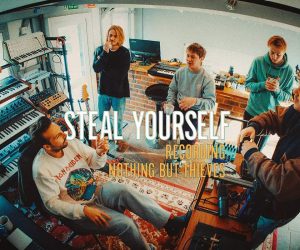



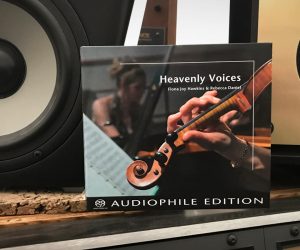

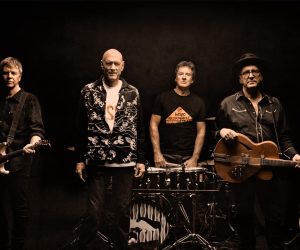







RESPONSES